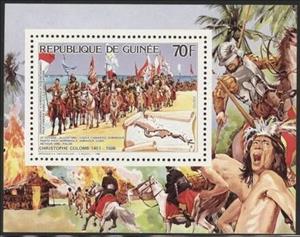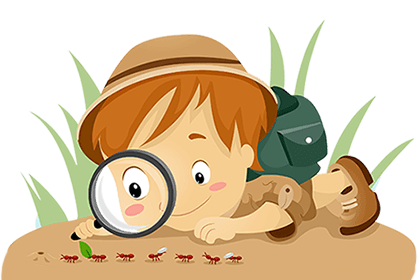Souvenir Sheet: 2nd Voyage: Debarkment in Hispaniola (Guinea 1986)
2nd Voyage: Debarkment in Hispaniola (Guinea 1986)
01 November (Guinea ) within release Columbus Discovering America goes into circulation Souvenir Sheet 2nd Voyage: Debarkment in Hispaniola face value 70 Guinean franc
| Souvenir Sheet 2nd Voyage: Debarkment in Hispaniola in catalogues | |
|---|---|
| Michel: | Mi: GN BL231 |
Souvenir Sheet is horizontal format.
Also in the issue Columbus Discovering America:
- Stamp - 1st Voyage: Construction of Fort Navidad face value 40;
- Souvenir Sheet - King Ferdinand and Columbus (1493) face value 600;
- Stamp - 3rd Voyage (1498-1500) face value 200;
- Stamp - 4th Voyage (1502-1504) face value 500;
- Stamp - 3rd Voyage (1498-1500) face value 200;
- Stamp - 2nd Voyage: Debarkment in Hispaniola face value 70;
- Stamp - 2nd Voyage: Debarkment in Hispaniola face value 70;
- Stamp - 4th Voyage (1502-1504) face value 500;
- Stamp - King Ferdinand and Columbus (1493) face value 600;
- Stamp - 1st Voyage: Construction of Fort Navidad face value 40;
- Souvenir Sheet - 1st Voyage: Construction of Fort Navidad face value 40;
- Souvenir Sheet - 2nd Voyage: Debarkment in Hispaniola face value 70;
- Souvenir Sheet - 3rd Voyage (1498-1500) face value 200;
- Souvenir Sheet - 4th Voyage (1502-1504) face value 500;
- Souvenir Sheet - King Ferdinand and Columbus (1493) face value 600;
Souvenir Sheet 2nd Voyage: Debarkment in Hispaniola it reflects the thematic directions:
Exploration is the process of exploring, an activity which has some expectation of discovery. Organised exploration is largely a human activity, but exploratory activity is common to most organisms capable of directed locomotion and the ability to learn, and has been described in, amongst others, social insects foraging behaviour, where feedback from returning individuals affects the activity of other members of the group
Famous People refers to the fame and public attention accorded by the mass media to individuals or groups or, occasionally, animals, but is usually applied to the persons or groups of people (celebrity couples, families, etc.) themselves who receive such a status of fame and attention. Celebrity status is often associated with wealth (commonly referred to as fame and fortune), while fame often provides opportunities to make money.
A flag is a piece of fabric (most often rectangular or quadrilateral) with a distinctive design that is used as a symbol, as a signaling device, or as decoration. The term flag is also used to refer to the graphic design employed, and flags have since evolved into a general tool for rudimentary signalling and identification, especially in environments where communication is similarly challenging (such as the maritime environment where semaphore is used). National flags are patriotic symbols with varied wide-ranging interpretations, often including strong military associations due to their original and ongoing military uses. Flags are also used in messaging, advertising, or for other decorative purposes. The study of flags is known as vexillology, from the Latin word vexillum, meaning flag or banner.
The horse (Equus ferus caballus) is one of two extant subspecies of Equus ferus. It is an odd-toed ungulate mammal belonging to the taxonomic family Equidae. The horse has evolved over the past 45 to 55 million years from a small multi-toed creature, Eohippus, into the large, single-toed animal of today. Humans began to domesticate horses around 4000 BC, and their domestication is believed to have been widespread by 3000 BC. Horses in the subspecies caballus are domesticated, although some domesticated populations live in the wild as feral horses. These feral populations are not true wild horses, as this term is used to describe horses that have never been domesticated, such as the endangered Przewalski's horse, a separate subspecies, and the only remaining true wild horse. There is an extensive, specialized vocabulary used to describe equine-related concepts, covering everything from anatomy to life stages, size, colors, markings, breeds, locomotion, and behavior.
A map is a symbolic depiction emphasizing relationships between elements of some space, such as objects, regions, or themes. Many maps are static, fixed to paper or some other durable medium, while others are dynamic or interactive. Although most commonly used to depict geography, maps may represent any space, real or imagined, without regard to context or scale, such as in brain mapping, DNA mapping, or computer network topology mapping. The space being mapped may be two dimensional, such as the surface of the earth, three dimensional, such as the interior of the earth, or even more abstract spaces of any dimension, such as arise in modeling phenomena having many independent variables. Although the earliest maps known are of the heavens, geographic maps of territory have a very long tradition and exist from ancient times. The word "map" comes from the medieval Latin Mappa mundi, wherein mappa meant napkin or cloth and mundi the world. Thus, "map" became the shortened term referring to a two-dimensional representation of the surface of the world.





